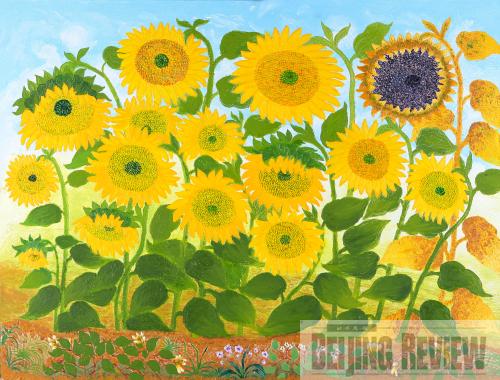|
Being real
The ultimate goal of her paintings is to reproduce the objects or scenes through her crayons, pens or brushes. Every figure has a name, every house has a history and every scene corresponds to some dribs and drabs of her memories.
 |
|
MINE IS BETTER: Chang said Dutch post-impressionist artist Vincent Van Gogh's sunflowers are not better than hers (CHANG XIUFENG) |
A small branch she picked up long ago in a garden turned into a painting that looks exactly like the object, including its size, the number of leaves, the subtle changes of colors and even the insect bites that left indents on the leaves.
"Isn't it cheating if my painting doesn't look like what it is?" she said. "The brush itself entails the risk of making things unreal through beautifying, and we will never know the original color and shape of objects under my brushes if I modify them many times."
Occasionally, her son and daughter-in-law will bring her to an art museum or to sketch outdoors, but using her imagination to paint is not the goal of the 75-year-old.
"I paint only real things to memorize the past, and want to tell stories from my experience through my paintings," she said.
This realistic style of painting makes her son—her first fan—feel emotionally connected and triggers flashbacks to his childhood. He said it is a mixture of innocent happiness, poverty and farming hardships. The painting elicits the same thoughts among Chinese audiences nationwide.
"I was touched when I saw her paintings two years ago," Chen said. "As an art school graduate, I have to admit that some professionals lack her insight into nature, people and colors."
While some see in the paintings memories, others feel a pure and serene heart.
"Both your mother and I are depicting art with our hearts, not with pens or machines," French photographer Klavdij Sluban said to Jiang, Chang's son.
Without any professional training, Chang ignores perspective and the principles of color harmony followed strictly by most academic painters. But her natural sense of color fuses with her memory of the countryside.
The cement jungle
Days with crayons and oil pastels in her small balcony-turned-studio have soothed Chang's loneliness and helped her to adapt to life in a strange city.
Chang was seized by hemiplegia that affected one side of her body more than 16 years ago. Jiang persuaded his mother to live with him in Guangzhou for better care in 2003, two years after his father died. But it was no easy transition for the village woman. Besieged by strangers speaking difficult dialects and confusing streets, she felt lost.
Roads and buildings carrying different signs made no sense to a person who couldn't read. She was not used to the polite indifference or outright negativity among urban residents.
After she broke two of her ribs in a 2004 accident and an eye disease weakened her sight in 2007, Chang grew unwilling to leave her apartment.
But she had her canvas when her son and daughter-in-law went to work. "I used to be busy with the children, farming and family things in the countryside. I didn't like to drop in and gossip about neighbors. I guess that's why I love painting now, " she said.
Her illiteracy and isolation gave her unlimited room to improve her art without being disturbed by outside information.
Chang learned to draw and paint all by herself in her studio. She has experimented with a number of painting materials to achieve the results she desires. She uses crayons, watercolor pencils, gouache, oil pastels and even wall paints to create her art.
She did not try painting on canvas until early 2008. Before that, she once tried to cover paper with white wall paint to depict the largest snowfall she remembers because "the paper was not white enough," Jiang quoted Chang as saying in the book.
She even uses toothpicks to sketch the veins of leaves. "Illiteracy makes you bold in attempting something new while a knowledgeable person is inclined to obey all kinds of rules and restrictions," she said.
But Chang never considered herself an artist. "An artist should be someone well-educated who has systematic and professional art training," she said.
Rewarding pursuits
Chang was already famous before the publishing of her book this June. She has twice been a guest on popular Chinese television talk show. She was also invited to hold an exhibition for charity in Hong Kong in 2007, where more than 100 of her paintings were displayed.
Still, recognition from both amateur and professional audiences does encourage her. Painting has become an indispensable part of her everyday routine. Now more skillful on the canvas, she spends about four hours a day in her studio working on her next project, a complete illustration of her biography.
The fact that painting is more rewarding than farming also inspired her. From her hard work, patience and perseverance she receives recognition, respect, admiration and money.
When she unexpectedly received her first remuneration of about 120 yuan ($22), she "grinned with delight," Jiang wrote. Back in her days in the village, she earned only 7 yuan ($1) a day drilling holes in logs on a small mushroom farm. | 